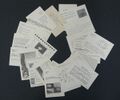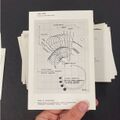User:Ohjian/Project Proposal
Project Proposal
What do you want to make?
I want to make a printed publication that brings together two parts:
- The project: An artistic exploration of the term Ghost Files
- The thesis: An academic essay about the methods, procedures and structures used in the project
While the project will follow an experimental, practical and artistic approach, the thesis will investigate the methods, procedures and structures that are used in it. The main interest of the thesis is to communicate how those methods and structures enable and influence artistic investigation.
Combining these two approaches in one final publication addresses artists, researchers and educators alike: The artistic project will be accompanied by a theoretical contextualization that embeds it into the discourse of artistic research practices. The thesis vice versa will be enriched by the practical, visual and intimate perspective of the artistic project.
The entanglement of this twofold investigation will become apparent through numerous cross-references between the two parts of the publication.
In the following proposal I will mainly focus and elaborate on the project part of the publication.
Genreal idea for the project
My project shall be an artistic investigation into Ghost Files, trying to delineate this ambivalent term that has no official meaning or definition. While the word Ghost may symbolize vagueness and immateriality, Files represent something concrete and tangible. This ambiguity of Ghost Files opens up a paradoxical terrain of (im)possibilities, oscillating between the no-more and the not yet, between nothing and everything at the same time.
I want to try and unpack this term in a series of experiments that I host for myself and others, focussing on different aspects of what it enfolds.
How do you plan to make it?
The following processes and tasks will be important to start the artistic investigation and step by step arrive to a final publication:
Hosting / facilitating
I imagine my artistic investigation to be a fusion of individual and collaborative sessions and experiments. I would like to try different forms of facilitation, which includes hosting sessions for myself, to create material around the idea of Ghost Files.
Experimenting / creating
To be more specific of what these experiments could be, here you can find examples of individual and collaborative sessions that have already been hosted:
– Collective session: Annotating Ghost Files
– Individual session: Possible Definitions
Documenting
The documentation of the experiments and their outcome is an important part of this project and will help to gather the material for the final publication. The documentation method as well as the way of archiving will depend on the form of the experiment and can be both digital as well as analog. Possible outcome:
– notes, annotations, lists, short stories, instructions, poems, reports
– drafts, schemes, photos, scans, drawings, mappings, screenshots
– logs, data, meta data, code
– sound recordings, electronic circuits
Next to the outcome of the session I want to document the setup (structure and method of facilitation) as well as a brief reflection.
Editing / Curating
The phase of editing and curating is very important to me. Not every session or experiment will lead to relevant, meaningful or even interesting outcome. So I want to make sure to review all material, trying to find common threads and connections as well as frictions and paradoxes. Based on these observations I want to sort and arrange the material in a way that creates one or several narratives and leads to new ways of understanding Ghost Files.
Making the publication
With the outcome of the artistic investigation and thesis in mind I have to plan and design the structure, format and layout for the final publication. This is the moment where the project and the thesis start to connect physically: in one book object and through numerous cross-references.
This book making process also includes printing and assembling the final publication.
What is your timetable?
September / October
– Research, reading
– think about structures for facilitation
– first small experiments
November / December
– Research, reading
– think about structures for facilitation
– ongoing individual and collective experiments
– documentation
January / February / March
– go through the material to find criteria or gaps that I would like to explore further
– try new structures for facilitation or repeat previous ones to meet the need to deepen the investigation
– sharpen and specify the individual and collective experiments
– documentation
April / June
Editing, curating and making the final publication
Why do you want to make it?
Why Ghost Files?
About ghosts:
„From a situation in which nothing can happen, suddenly anything is possible again“
(Fisher, 2009, p. 81)
The term Ghost Files will function as the entry point, the subject and the lens for this artistic investigation. The combination of the words Ghost and Files came up while working on a project during the last year and since then I cannot let it go. The dichotomies of fictional and factual, indefinite and absolute, immaterial and material that come together in the term Ghost Files fascinate, inspire and haunt me. At the same time, the fact that this term has no official definition seems like an invitation to fill it with matter and meaning, be it imaginative and speculative or factual.
I want to investigate the poetics, aesthetics, materiality and inner logic of Ghost Files, trying to grasp what is there but at the same time not actually there. I want to search for the abandoned and the overlooked, the lost souls that somehow stay with us, even haunt us at times.
Why an artistic investigation?
For my project I chose the format of an artistic investigation. What I mean by that is to position myself at the intersection of making and analyzing, to combine subjective experience and imagination with fact-based knowledges.
This approach allows for a plurality of possibilities, for many different perspectives to co-exist and, following the theory of Situated Knowledges by Donna Haraway (Haraway, 1988), enables new ways of seeing and knowing.
Who can help you and how?
To facilitate the collaborative sessions I will have to find participants that are curious to investigate Ghost Files with me. I will make use of the Public Moments and additionally send invitations within the XPUB network and via The Piet newspaper.
I will also invite some friends and previous students of mine to join group sessions.
From all participants I am hoping to get not only fresh ideas and new insights into Ghost Files, but also feedback on the sessions.
For all prototyping questions that will come up I hope to get the support of Manetta and Joseph, especially when it come to small code experiments and electronic circuits.
For long conversations, reflections and speculations I hope for the support of my classmate Supisara. We share a fascination for Ghost Files and I know that I will find some inspiration and hope in difficult moments.
Around the production of the final publication I count on the support of my classmate Gersande, who could help me out with tipps and contacts. Also I will rely on the facilities of the publication station of WDKA.
Relation to previous practice
Previous to XPUB I have mostly positioned myself either at the beginning or at the end of a publishing process: As a workshop host I would initiate a project and provide a structure and space for participants to create material. As a graphic designer with a strong interest in book making I would structure, curate and design pre-existing material to form a publication from it.
With this project I want to explore a new role and start from the middle: Accompanied by the familiar processes of hosting and curating I now also want to create material for a publication. By integrating all three roles into my artistic investigation I aim to trigger an iterative process towards a more entangled, less divided publishing practice where hosting, creating and curating shape and inspire each other.
Relation to a larger context
In this section I will list a few artists, artist publications and artistic research projects that I find inspiring.
Dieter Roth: 264 Little Clouds (1968)
264 Little Clouds is an artist publication by D. Roth in collaboration with the poet Emmett Williams. It could be described as the documentation of a collaborative creative process. Roth sent his initial text clouds to Emmett with the invitation to interact with them. Emmett decided to separate Roths little text clouds onto blank cards and send them back to him for illustration.
Lucy Lippard: The Number Shows (1969 - 1974)
The curator and artist Lucy Lippard curated a series of four Conceptual art exhibitions called the Number Shows. The first of these shows was 557,087 in the Seattle Art Museum. All exhibitions were accompanied by a reinvented form of an exhibition catalog: loose cards in an envelope, containing notes, documentation, drafts and conceptual works by each artist, representing different approaches, perspectives and understandings of how to document an art exhibition.
Cordula Dauß: Toponymische Hefte (2010, ongoing)
Dauß is a writer and artist working across theory, fiction and performance. In a series of semifictional artist publications about toponyms (words that are the name of a place) she explores mechanisms of meaning-making in a literal and situated way. By interweaving fiction and factual knowledge she shakes the structure of meaning-making.
Ines Cox: SAVE (2019)
SAVE is the outcome of a visual research by the artist, designer and educator Ines Cox. In this book she documents seemingly unimportant byproducts of her digital work process. By collecting these artifacts that take the form of photographs, drawings, prints and screenshots she reveals the conditions of our time and how graphic designers create and see content.
Offshore studio – (2021, 2022)
Offshore is a graphic design studio that works on the intersection of design, journalism, research and curating. Managing the Wild (2021) is an artistic research project focussing on narratives and myths about the wolf in Western Europe.
The Energy Atlas (2022) is a collective visual research publication about the hidden layers and political entanglement of energy.
Dispozitiv Books (2021, 2022)
Obsession Never Sleeps (2021) is a catalog that accompanies an exhibition with the same name. The Future of Ghosts (2022) is a magazine about the future of ghosts.
References/bibliography
- Cox, I. (2019) SAVE Antwerp: Royal Academy of Antwerp.
- Dauß, C. (2010) Toponymisches Heft No. 1. Das Trujillo-Syndrom Berlin: Fantôme Verlag.
- Fisher, M. (2009) Capitalist Realism: Is there no Alternative? London: Zero Books, p. 81.
- Haraway, D. (1988) Situated Knowledges: The Science Question in Feminism and the Privilege of Partial Perspective. Feminist Studies, Inc, pp.575-599.
- Hindahl, P. and Mogos, P. (2021) Obsession Never Sleeps Bucharest: Dispozitiv Books.
- Lippard, L. (1969) 557,087 Seattle: Seattle Art Museum.
- Naum, L. and Mogos, P. (2022) The Future of Ghosts Bucharest: Dispozitiv Books.
- Roth, D. (1968) 264 Little Clouds New York: The Something Else Press.















